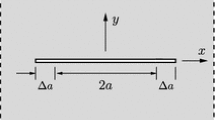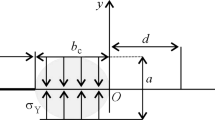Abstract
Several theories in fracture mechanics apparently approach the problem of crack extension from different points of view but lead to the same main result. Thus, in the case of brittle cracks, an equivalence exists between the Griffith energy criterion, the Barenblatt cohesion modulus theory, and the assumption of a critical mean stress at an end-region of fixed size. It is shown that the feature common to these theories is the adoption (explicitly stated or not) of an autonomous end-region, and that this assumption alone is sufficient for arriving at the principal results.
In the case of brittle materials, the end-region acts as an instability kernel. This region develops into an instable region at a certain load, and crack extension takes place. The instability is clearly associated with the atomic force-distance relations. The interatomic distance thus provides the characteristic length needed to assure the existence of an autonomous end-region.
It is suggested that similar instable end-regions may develop also in non-brittle materíals. The characteristic length is here given by different kinds of imperfections.
If no other characteristic length than the dimensions of the crack can be found, then a conclusion must be that the fracture stress is independent of the size of the crack.
Résumé
II existe plusíeurs théories de la mécanique de rupture qui, apparemment, abordent le problème de l'extension dune fissure selon des points de vue différents, et qui néanmoins conduisent sensiblement au même résultat. Ainsi, dans le cas de fissures fragiles, il existe une équivalence entre le critère d'énergie dû à Griffith, la théorie du module de cohesion de Barenblatt, et l'hypothèse dune contrainte moyenne critique en une region terminale de dimensions déterminés.
On montre que la caractéristique commune a ces theories est l'hypothèse — explicite ou non — dune région terminale autonome, et que cette seule hypothèse est suffisante pour aboutir aux principaux résultats.
Pour les matériaux fragiles, la region terminate fait office de nodule d'instabilité. Cette region se développe en région d'instabilité à partir d'une certaine charge, et il se produit une extension de la fissure. L'instabilité est clairement associée aux relations entre distances et forces interatomiques. La distance interatomique fournit done la longueur caracteristique néeessaire à l'existence dúne région terminale autonome.
On suggère que des regions instables de même nature peuvent se développer également dans les matériaux ductiles. Ici, la longueur caractéristique est donnée par diverses sortes d'imperfections.
S'il West pas possible de trouver d'autre longueur caractéristique que les dimensions de la fissure, on doit en conclure que la tension de rupture ne depend pas de l'étendue de celle-ci.
Zusammenfassung
Das Risserweiterungsproblem wurde offenbar Yon mehreren frakturmechanischen Theorien unter verschiedenen Gesichtspunkten behandelt. Man erhielt trotzdem das gleiche Hauptresultat. Folglich besteht im Falle von spröden Rissen ein Äquivalent zwischen dem Griffischen Energiekriterion, der Barenblatt Kohäsionsmodultheorie und die Annahme eines kritischen Durchschnittsgewichts bei einem Endgebiet von feststehender Grösse. Es wurde gezeigt, dass das Hauptmerkmal zu diesen Theorien gewöhnlich die Adoption (ob ausdrücklich erwähnt oder nicht) eines autonomen Endgebietes ist und dass these Voraussetzung allein genügt, um zu dem hervorragenden Resultat zu gelangen.
Im Falle von spröden Materialen handelt das Endgebiet als ein Unbeständigkeitskern. Dieses Gebiet entwickelt sich unter gewisser Last, in ein unbeständiges Gebiet und Risserweiterung findet statt. Es besteht ein klarer Zusammenhang zwischen der Unbeständigkeit und der atomartigen Druckentfernung. Die zwischenatomartige Entfernung liefert die benötigte Länge, um die Existenz eines autonomen Endgebietes zu sichern.
Es wurde darauf aufmerksam gemacht, das ähnliche unbeständige Endgebiete auch in nichtspröden Materialen entwickelt werden können. Die characteristische Länge wird hier durch verschiedene Arten von Unvollkommenheiten erhalten.
Wenn man keine andere characteristische Länge als die Dimension des Risses finden kann, dann muss man zu der Schlossfolgerung kommen, dass der Bruchdruck von der Grösse des Risses unabhängig ist.
Similar content being viewed by others
References
A.A.GriffithPhil. Trans Roy. Soc., A221, 163–198 (1920).
G. Kolosov Doctoral dissertation, Dorpat. (1909). See: Z. Math. Phys., 62 (1914).
G.E.InglisTrans. Inst. Nav. Arch., 55, 219–230 (1913).
G.I.BarenblattAdv. Appl. Mech., 7, 55–129 (1962).
J.R.WillisJ. Mech. Phys. Solids, 15,151 (1967).
J.A.Hult and F.A.McClintockProc. 9th Inter. Congr. Appl. Mech., Brussels, 8, 51 (1957).
D.S.DugdaleJ. Mech. Phys. Solids, 8, 10 (1960).
K.B.BrobergArkiv för Fysik (Stockholm), 18,159–192 (1960).
K.B.BrobergJ. Appl. Mech., 31 546–547 (1964).
K.B.BrobergDiscussion of fracture from the energy point of view; to be published in the Folke Odqvist Volume: Recent Progress in Applied Mechanics, Almqvist & Wiksell/Gebers, Stockholm (1967).
E.Orowan‘Fundamentals of Brittle Behavior in Metals’, Fatigue and Fracture of Metals, Wiley, New York (1950).
Author information
Authors and Affiliations
Rights and permissions
About this article
Cite this article
Broberg, K.B. Critical review of some theories in fracture mechanics. Int J Fract 4, 11–19 (1968). https://doi.org/10.1007/BF00189139
Received:
Issue Date:
DOI: https://doi.org/10.1007/BF00189139




